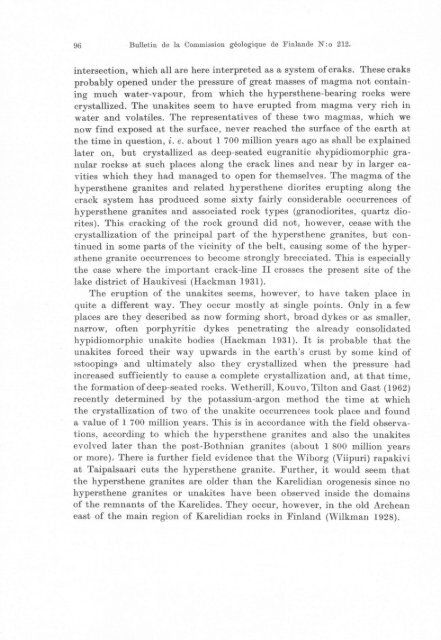COMMISSION GEOLOGIOUE - Arkisto.gsf.fi
COMMISSION GEOLOGIOUE - Arkisto.gsf.fi
COMMISSION GEOLOGIOUE - Arkisto.gsf.fi
You also want an ePaper? Increase the reach of your titles
YUMPU automatically turns print PDFs into web optimized ePapers that Google loves.
96 Bulletin de la Commission geologique de Finlande N: 0 212.<br />
intersection, which all are here interpreted as a system of craks. These craks<br />
probably opened under the pressure of great masses of magma not containing<br />
much water-vapour, from which the hypersthene-bearing rocks were<br />
crystallized. The unakites seem to have erupted from magma very rich in<br />
water and volatiles. The representatives of these two magmas, which we<br />
now <strong>fi</strong>nd exposed at the surface, never reached the surface of the earth at<br />
the time in question, i . e. about 1 700 million years ago as shall be explained<br />
later on, but crystallized as deep-seated eugranitic )}hypidiomorphic granular<br />
rocks)} at such places along the crack lines and near by in larger cavities<br />
which they had managed to open for themselves. The magma of the<br />
hypersthene granites and related hypersthene diorites erupting along the<br />
crack system has produced some sixty fairly considerable occurrences of<br />
hypersthene granites and associated rock types (granodiorites, quartz diorites).<br />
This cracking of the rock ground did not, however, cease with the<br />
crystallization of the principal part of the hypersthene granites, but continued<br />
in some parts of the vicinity of the belt, causing some of the hypersthene<br />
granite occurrences to become strongly brecciated. This is especially<br />
the case where the important crack-line II crosses the present site of the<br />
lake district of Haukivesi (Hackman 1931).<br />
The eruption of the unakites seems, however, to have taken place in<br />
quite a different way. They occur mostly a.t single points. Only in a few<br />
places are they described as now forming short, broad dykes or as smaller,<br />
narrow, often porphyritic dykes penetrating the already consolidated<br />
hypidiomorphic unakite bodies (Hackman 1931). It is probable that the<br />
unakites forced their way upwards in the earth's crust by some kind of<br />
»stooping)} and ultimately also they crystallized when the pressure had<br />
increased suf<strong>fi</strong>ciently to cause a complete crystallization and, at that time,<br />
the formation of deep-seated rocks. Wetherill, Kouvo, Tilton and Gast (1962)<br />
recently determined by the potassium-argon method the time at which<br />
the crystallization of two of the unakite occurrences took place and found<br />
a value of 1 700 million years. This is in accordance with the <strong>fi</strong>eld observations,<br />
according to which the hypersthene granites and also the unakites<br />
evolved later than the post-Bothnian granites (about 1 800 million years<br />
or more). There is further <strong>fi</strong>eld evidence that the Wiborg (Viipuri) rapakivi<br />
at Taipalsaari cuts the hypersthene granite. Further, it would seem that<br />
the hypersthene granites are older than the Karelidian orogenesis since no<br />
hypersthene granites or unakites have been observed inside the domains<br />
of the remnants of the Karelides. They occur, however, in the old Archean<br />
east of the main region of Karelidian rocks in Finland (Wilkman 1928).
















